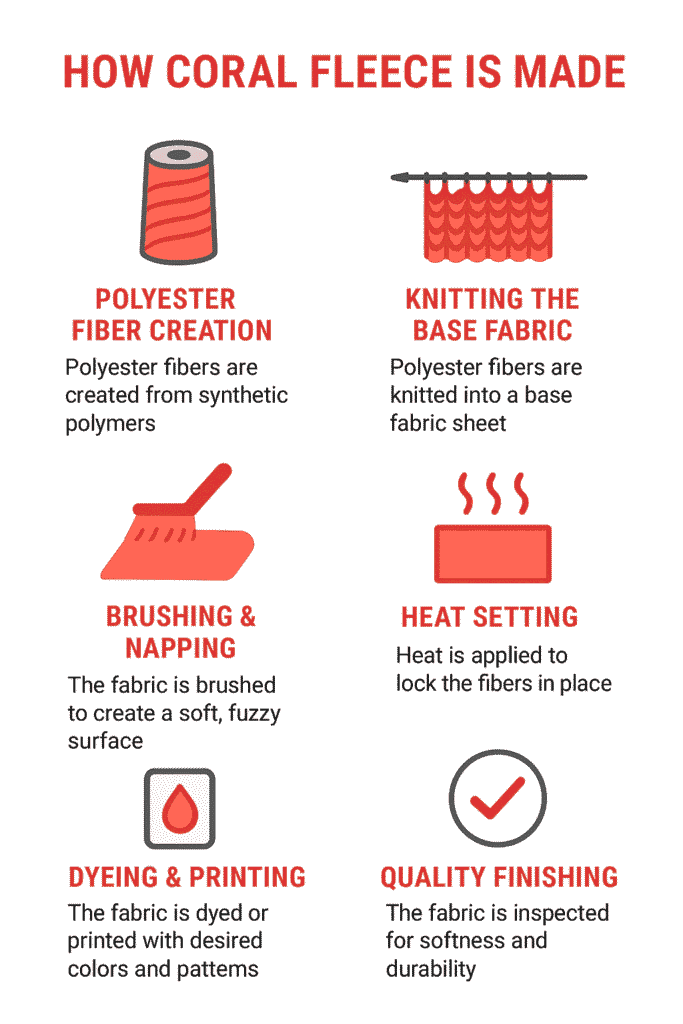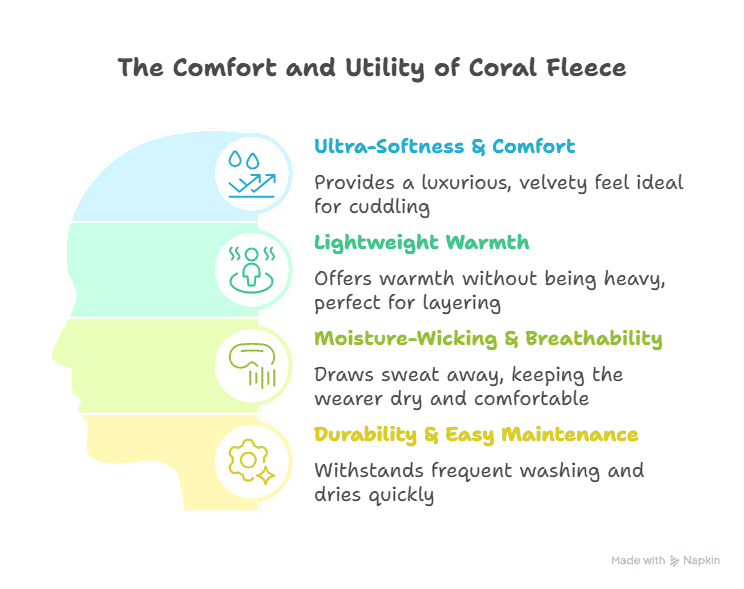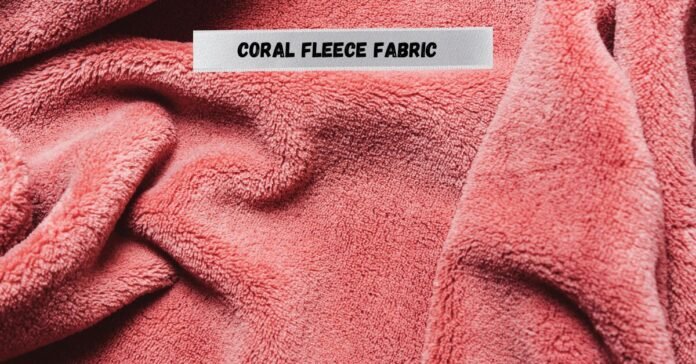Introduction
When one states the question, what is coral fleece, one simply states that it is just like soft fluffy polyester cloth. It is well-known as a soft-touch product with a fuzzy surface and a warm feel that makes it an instant hit as a home textile item and a popular fashion item. It is both light and insulating thus fits well in cold climates. Coral fleece is named after its peculiar feel; it feels like soft coral.
No fabric has the texture and feel of this material. It feels extremely soft to wipe, and it feels luxurious, yet does not feel heavy. This fabric has fibers that are brushed and raised to form a fuzzy surface thus trapping heat all through. It does not weigh the body down as heavy wool or cotton fleece does and can offer warmth.
Among the other fleece qualities, this fabric is soft and durable when compared to others. Polar fleece is more solid and dense in comparison to microfleece that is slimmer and more suitable in activewear. Sherpa fleece is a duplication of the wool fluffy feel but may be bulkier. This one has the right spot at being comfortable, warm and lightweight.
History & Origin of Coral Fleece
The fabric appeared as an adaptation of polar fleece at the end of the 20th century. During the period when the advancement of textile technology took place, manufacturers tried out new brushing methods that would make the polyester fabrics smoother. This gave rise to the creation of a smoother, finer fleece than the normal version.
It is the upgraded version of traditional polyester fleece. Through improvements in the brushing/napping technique, fabric manufacturers could develop a more dense yet lighter weight material. The outcome was a fleece that was silkier and softer but did not lose the advantages of the insulation provided. Its surface texture probably gave the name of this cloth to this species. It has fibers that resemble the soft coral branches and hence distinctly wave like. This association to nature was the reason why the name was marketable and descriptive.
How Coral Fleece Is Made

Step 1: Polyester Fiber Creation
It begins with polyester that is manmade fiber of polymer based on petroleum. The raw material is melted and are extruded through fine strands of spinnerets, which are long and fine strands. They are light in weight, strong and non-shrinkable. This is because they are well known to be durable and therefore a good foundation when it comes to manufacturing warm fabrics such as this one.
Step 2: Knitting the Base Fabric
After preparing polyester fibers, knitting of base fabric sheet is done. This action of knitting makes the fabric be flexible without the weakening of the fabric strength. The knit structure enables the fabric to stretch a little bit which makes it comfortable in clothing. At this point, the cloth is smooth and flat in a sense that it awaits further processing.
Step 3: Brushing & Napping
The fabric undergoes brushing process and it is done by special machinery characterized by rotating wire rollers. The fibers are lifted and teased beneath these rollers to give the fuzzy, velvet feel this fleece has. The fabrics gain thinness and softness the more they are brushed and napped. The step imparts its trademark fluffy feel and coziness.
Step 4: Heat Setting
Controlled heating is used to set the fabric to fix the raised fibers in their place. This fixes the brushed surface to be fluffy after many washes. Pasteurization also promotes wrinkle and dimensional stability. In the absence of this procedure, the fibers would crimp in a short time and lose tenderness.
Step 5: Dyeing & Printing
Once textured, the fabric is dyed or printed to come up with the required color and patterns. Deep dye baths are used to acquire solid colors and printing techniques, which support creative designs, are of advanced standards. That is why this fabric can be found in basic colors but also fun prints in children. Dyeing is used to impart vividness as well as to embellish the qualities of the fabric.
Step 6: Quality Finishing
During the last phase, quality finishing of this fleece takes place to enhance performance. The cloth is assayed on basis of softness, thickness and uniformity of the cloth. Certain types are even treated to be pilling resistant making them last long and be of a new look. Eco-friendly alternatives can employ recycled polyester, which provide sustainability with a boost, without sacrificing comfort.
Types of Coral Fleece
Standard Coral Fleece
Standard Fleece is the most common plush fabric which majority of people consider is the standard one. Soft, fuzzy and 100% polyester. Classic fleece with an even pile & soft smooth feel. It is often sold by the yard for crafting and it is also used for a lot of blankets and loungewear. Because it isn’t treated, the fibers can bleed or produce the small pills until it’s laundered.
Anti-Pill Coral Fleece
Anti-pill version is treated to ensure no pilling. Manufacturers use anti-pill treatments or use heavier weight fibers. The outcome is a even top surface remains new looking longer. It withstands many washes, which makes it perfect for heavy use items such as children’s blankets, pet bed.
Heavyweight vs. Lightweight Coral Fleece
This fabric is available in many thicknesses. A delicately light version is problem free, advise perfect for jackets or throw blankets. Different from heavyweights (thick and fluffy). It may be 300 GSM or higher, and is best for thick blankets or winter coats. Heavyweight fleece holds heat better and feels like really nice fleece, and lightweight fleece is airier. In general a higher GSM means more warmth.
Printed & Dyed Coral Fleece
This material may be printed or dyed in all sorts of layouts. Fabrics are solid colors or they come in cartoon patterns, plaids, or geometric prints. Polyester fibers bind dye well so it keeps vibrant, long-lasting color. This makes printed versions loved in decorated baby blankets, kids bedding and making handicrafts.
Blended Coral Fleece
There is some coral fleece blending with other fibers to attain special properties. By way of example, cotton is added to increase breathability and some spandex to add stretch. These blends are typically labelled by their fiber ratios as 95 per cent polyester/5 per cent spandex. These have the same ranges of soft and plush blends but with an added comfort or functionality. They are empirically worn in sports or tight lounge outfits.
Key Features & Benefits of Coral Fleece

Ultra-Softness & Comfort
Super soft coral fleece’s ultimate softness give a luxurious velvety pile that feel like getting wrapped in a warm, soft hug. This warm feel makes it prefect for cuddling or loungewear. Even for babies and sensitive skin it is gentle. This fleece feels more pampering than many of other fabrics such dense fibers.
Lightweight Warmth
Lightweight, yet soft to the touch, this fleece is. It warms without being heavy. Thick pile retains warmth surrounding the body, gives an excellent insulation. But the fabric itself is lightweight so it layers well. It’s also comfortable for lounging, or, as an under layer under your jacket.
Moisture-Wicking & Breathability
It is also a moisture wicking fabric. Polyester fibers draw sweat off the skin and allow it to evaporate, meaning that the material does not feel clammy. That is why fleece is worn as sleepwear and loungewear—because of this moisture-wicking capacity.
Durability & Easy Maintenance
This material is hard wearing and maintainable. It does not tear, and can withstand numerous washes. It can be washed by machine and is air-dried faster without wearing out. Going by the information that has been given, it is apparent that this fabric remains good to look or feel in a regular usage.
Common Uses of Coral Fleece
- Clothing: Hoodies, pajamas, and robes.
- Home textiles: Blankets, throws, and pillow covers.
- Baby & kids’ products: Swaddles, onesies, baby blankets and soft toys.
- Pet accessories: Beds, jackets, and blankets.
Coral Fleece vs. Other Fabrics
Coral Fleece vs. Polar Fleece
Compared to the polar version, this fleece contains pile that is higher and fluffier. This additional pile traps additional air and it remains slightly warmer. Polar fleece in its turn is lighter, and more compact, and will serve better as breathable material in jackets and layers.
Coral Fleece vs. Cotton Fleece
Cotton fleece (brushed cotton) is soft and comfortable to wear, but is poor insulation compared to this polyester fleece. The cotton is humidity absorbing and it is appropriate in temperate weather conditions. Conversely, polyester fibers in this one warm you when it is chilly. Cotton fleece is popular in cool spring (or indoor) wear, and this fabric when extra warmth is needed. Briefly, this one is more effective in retaining heat and cotton fleece feels light.
Coral Fleece vs. Wool
Both wool and this fleece are good insulators, but not alike. Wool is organic, and its fibers have a crimp which retains the heat even when wet and does not seal up. This material, instead, is less solid and is quick to dry. Wool is however warmer. The raw materials that are used are better in their respective qualities: wool is breathable and this fleece is soft and easy to care.
How to take care of Coral Fleece
Cleaning/ Laundry: Machine wash this fabric in cold or lukewarm water on a gentle cycle. Use a mild detergent and avoid bleach or fabric softeners.
Drying: Dry tumble on low heat or air dry. High heat can damage the fibres and reduce the plushiness of the fabric.
Reducing Pilling: Turn outerwear inside out before washing to prevent friction getting on the pile.
Is Coral Fleece Warmer than Cotton?
Yes. Coral fleece is often warmer than cotton fabrics as it has thick, densely-packed piles. It warms up amazingly as it’s thick, fluffy design traps body heat really well. Compared to it, cotton fleece or cotton clothes feel cooler because cotton cannot hold heat as good. So for Winter bedclothes or loungewear, coral fleece tends to be warmer than with identical cotton pieces.
Best Coral Fleece Blankets for Winter
To use on the extremely cold nights, thick coral fleece blankets work well. It must have a high GSM (300+), with the weightier blankets trapping greater heat. Plush throws, and reversible coral-sherpa blankets, are popular. Buy a fabric with light weight and review to ensure softness.
How to Wash Coral Fleece Without Damaging It
Wash coral fleece by following the correct care. Wash with cold water and use a mildly detergent and gentle cycle. Do not use bleach and/or fabric softeners as they may break the fibers, making it harder to soften them. Wash inside out to save the nap. Wash and tumble-dry on low temperature or dry by air the piece after washing. Intense heat can make it shrink and make the fleece less fluffy. Look at the care label and see if there is any special care requirements in the garment. By adhering to these tips, you will be able to maintain softness and fluffiness of the condition of your coral fleece products more than once.
Where to Buy Coral Fleece Products
Products made out of coral fleece are easily found on the internet and in the physical shops. The best commonly purchased ones are Amazon Basics, Bedsure, and Patagonia. The basic versions are excellent in everyday applications whereas the premium brands produce heavier/more luxurious versions. Make sure to check reviews and weight of fabric before ordering any of the products.
Sustainability & Environmental Impact
Coral fleece is manufactured using synthetic polyester, which conjures a few issues of environmental concern. Polyester is derived of petroleum and not biodegradable. This implies that discarded coral fleece has the capability to remain intact several years in landfills. In addition, microplastic fibers also enter water bodies in the cleaning of coral fleece. Traditional coral fleece is relatively unenviromentally-friendly, in other words.
Nevertheless, there is recycled coral fleece alternatives. These are recycled through the manufacture of polyester utilizing used PET (plastic bottles). Recycled coral fleece has all the same ultra-softness and blanket-like warmth of new coral fleece. By recycling fabrics we get to minimize pollution and save resources. When shopping, consider products that are labeled as recycled or recycled coral fleece or suchlike.
Conclusion-
So what is the coral fleece? It is an ultra-soft polyester fabric with plush and warm feel. And its transformation out of polar fleece provided us with the lightweight but warm fabric, and long-lasting, but soft one. Coral fleece has found its niche as a favorite material whether in the baby products, garments or blankets. Properly taken care of and making environmentally friendly decisions, coral fleece can be sustainable and practical.
Read More>> about Cashmere wool.
FQAs
Coral fleece is highly warm and takes cold weather. It is insulated quite nicely and thus may become too warm during the summer.
The coral fleece material is constructed out of polyester, which does not shrink. Cleaning in cold water and tumble-drying at low temperature will avoid the majority of shrinkage.
Both provide good insulation with a larger portion of warmth usually provided by the wool. Wool fibers insulate against both heat and moisture, and coral fleece is very warm and dries swiftly even in the wet state. Both are good in their way: wool is warmer by nature, coral fleece is softer and easier to take care of.
Yes, as with all polyester textiles coral fleece can statically charge up. To help reduce cling, a dryer sheet can be added during the wash, or vinegar added during the rinse.

I really appreciate how clearly you broke down the production process of coral fleece, especially the brushing and napping step—it explains why the fabric feels so plush compared to other fleece types. One thing I’ve noticed is that while it’s warm, it doesn’t trap heat in the same way wool does, which makes it a great option for people who want coziness without overheating. Have you found that its moisture-wicking quality holds up well after multiple washes?